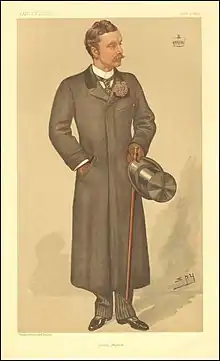Richard Curzon, 4th Earl Howe
Richard George Penn Curzon, 4th Earl Howe, GCVO, TD, JP (28 April 1861 – 10 January 1929), styled Viscount Curzon between 1876 and 1900, was a British courtier and Conservative politician. He served as Treasurer of the Household between 1896 and 1900 and was Lord Chamberlain to Queen Alexandra between 1903 and 1925.
The Earl Howe | |
|---|---|
 "South Bucks". Caricature by Spy published in Vanity Fair in 1896. | |
| Lord-in-Waiting Government Whip | |
| In office 30 October 1900 – 1 October 1903 | |
| Monarch | Victoria Edward VII |
| Prime Minister | The Marquess of Salisbury Arthur Balfour |
| Preceded by | The Earl of Clarendon |
| Succeeded by | The Earl of Erroll |
| Treasurer of the Household | |
| In office 11 February 1896 – 30 October 1900 | |
| Monarch | Victoria |
| Prime Minister | The Marquess of Salisbury |
| Preceded by | Marquess of Carmarthen |
| Succeeded by | Victor Cavendish |
| Member of the House of Lords Lord Temporal | |
| In office 26 September 1900 – 10 January 1929 Hereditary Peerage | |
| Preceded by | The 3rd Earl Howe |
| Succeeded by | The 5th Earl Howe |
| Member of Parliament for Wycombe | |
| In office 18 December 1885 – 25 September 1900 | |
| Preceded by | Gerard Smith |
| Succeeded by | William Grenfell |
| Personal details | |
| Born | 28 April 1861 |
| Died | 10 January 1929 (aged 67) |
| Nationality | British |
| Political party | Conservative |
| Spouse(s) | (1) Lady Georgiana Spencer Churchill (1860–1906) (2) Florence Davis (d. 1925) (3) Lorna Curzon (d. 1961) |
| Alma mater | Christ Church, Oxford |
Background and education
Curzon was the eldest son of Richard Curzon-Howe, 3rd Earl Howe, and wife Isabella Maria Katherine Anson, daughter of Major-General The Hon. George Anson and wife The Hon. Isabella Elizabeth Annabella Weld-Forester.[1]
He was educated at Eton and Christ Church, Oxford.
Political career
In 1885, Curzon was elected Member of Parliament for Wycombe.[1][2] He became a government member when he was appointed Treasurer of the Household under Lord Salisbury in 1896,[3] a post he held until 1900,[4] when he inherited his father's titles and gave up his seat in the House of Commons.[1][2] From 1900[4] to 1903[5] he served as Lord-in-waiting under Salisbury and then Arthur Balfour. In 1903 he was made a Knight Grand Cross of the Royal Victorian Order[6] and appointed Lord Chamberlain to Queen Alexandra.[7][8] He served in that post until the Queen's death in 1925.[1]
Lord Howe was also a captain in the Prince Albert's Own Leicestershire Yeomanry Cavalry, an honorary lieutenant-colonel in the 2nd Battalion of the Leicestershire Volunteer Regiment and a Justice of the Peace for Buckinghamshire.[1]
His brother-in-law, Lord Randolph Churchill, appointed him one of his two literary executors; in that capacity he gave his consent to Winston Churchill writing the biography of his father, although with some reluctance.
Family
Lord Howe married Lady Georgiana Elizabeth Spencer-Churchill (14 May 1860 – 9 February 1906), the fifth daughter of John Spencer-Churchill, 7th Duke of Marlborough, and wife Lady Frances Anne Emily Vane, on 4 June 1883 at St George's, Hanover Square. Thus, he was Winston Churchill's uncle by marriage. They had one son, Francis. Lady Georgiana Curzon and Lady Chesham initiated in December 1899 the funding of a hospital to be sent to South Africa with the Imperial Yeomanry fighting in the Second Boer War. They raised more than £100,000, leading to the creation of the Imperial Yeomanry Hospital, with a base hospital, a field hospital and bearer companies.[9]
After his first wife's death in 1906, Curzon married Florence, Dowager Marchioness of Dufferin and Ava, in 1919. After her death in 1925, he married his first cousin once removed, Lorna Curzon. He died in January 1929, aged 67, and was succeeded by his only son, Francis. The Countess Howe died in February 1961.[1]
References
- thepeerage.com Richard George Penn Curzon, 4th Earl Howe
- Leigh Rayment's Historical List of MPs – Constituencies beginning with "W" (part 5)
- "No. 26709". The London Gazette. 14 February 1896. p. 857.
- "No. 27253". The London Gazette. 4 December 1900. p. 8211.
- "No. 27609". The London Gazette. 27 October 1903. p. 6531.
- "No. 27613". The London Gazette. 6 November 1903. p. 6851.
- "No. 27602". The London Gazette. 2 October 1903. p. 6027.
- Naval officers, Charles Benedict Davenport, Mary Theresa Scudder, 1919, p.106
- "The War - The Prince of Wales and the Imperial Yeomanry Hospital". The Times (36088). London. 13 March 1900. p. 6.
External links
- Hansard 1803–2005: contributions in Parliament by the Earl Howe
| Parliament of the United Kingdom | ||
|---|---|---|
| Preceded by Gerard Smith |
Member of Parliament for Wycombe 1885–1900 |
Succeeded by William Grenfell |
| Political offices | ||
| Preceded by Marquess of Carmarthen |
Treasurer of the Household 1896–1900 |
Succeeded by Victor Cavendish |
| Preceded by The Earl of Clarendon |
Lord-in-waiting 1900–1903 |
Succeeded by The Earl of Erroll |
| Court offices | ||
| Preceded by The Viscount Colville of Culross |
Lord Chamberlain to Queen Alexandra 1903–1925 |
Office abolished Death of Queen Alexandra |
| Peerage of the United Kingdom | ||
| Preceded by Richard Curzon-Howe |
Earl Howe 2nd creation 1900–1929 |
Succeeded by Francis Curzon |